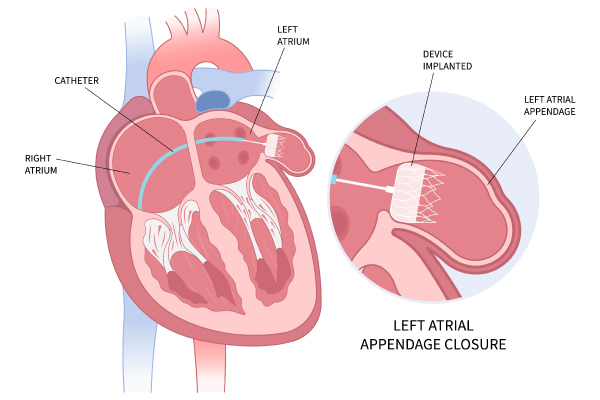Procedures
Left Atrial Appendage Closure (LAAC)
The left atrial appendage (LAA) is a small sac in the left atrium of the heart where most blood clots that cause strokes in patients with atrial fibrillation (a common heart rhythm disorder) originate.
In most patients with atrial fibrillation, blood thinning medication is used to reduce their risk of stroke. However, in some patients who are at high risk of bleeding, blood thinning medications cannot be used and these patients may benefit from left atrial appendage closure (LAAC). This is a minimally invasive “keyhole” heart intervention procedure that is performed to reduce the risk of stroke in patients with atrial fibrillation (AFib) who cannot take blood thinning medication.

Call for Appointment
(02) 9646 4044
Procedures Expertise
Coronary Angiography & Stenting
Electrophysiology Study and Catheter Ablation
Everything you need to know about
Left Atrial Appendage Closure (LAAC)
How effective is Left Atrial Appendage Closure (LAAC) in preventing strokes?
LAAC has been shown to be highly effective in reducing the risk of stroke in patients with atrial fibrillation who are at high risk for stroke and cannot take blood thinners.
How is Left atrial appendage closure (LAAC) performed?
LAAC is performed under general anaesthesia. The procedure involves inserting a catheter through a small incision in the groin and guiding it up to the heart. The device is then implanted in the left atrial appendage, where it stays in place permanently.
How long does the Left atrial appendage closure (LAAC) procedure take?
The LAAC procedure typically takes around one to two hours.
How long do I need to stay in the hospital after the LAAC procedure?
Most patients can go home the day after the procedure. However, this may vary depending on the individual case.
What is the recovery time after LAAC?
The recovery time after LAAC varies from patient to patient, but most patients are able to return to their normal activities within a few days to a week after the procedure.
Will I still need to take blood thinners after LAAC?
In most cases, blood thinners like warfarin or NOACs can be stopped after LAAC, though low dose aspirin may be required for a few months after closure.
What activities should I avoid after the LAAC procedure?
Patients should avoid strenuous activities for a few days after the procedure, and refrain from lifting heavy objects for at least a week after the LAAC procedure. Our team will provide specific instructions based on your individual case.
How soon can I return to work after the LAAC procedure?
This will depend on the individual case and the type of work you do. Patients with sedentary jobs can return to work within a few days, while those with more physically demanding jobs may need to take more time off. Our team will provide specific guidance on post-procedure care.
Call for Appointment
(02) 9646 4044
Procedures Expertise
Coronary Angiography & Stenting
Electrophysiology Study and Catheter Ablation
Structural Heart Intervention Procedures
Transcatheter Aortic Valve Implantation (TAVI) | Balloon Mitral Valvuloplasty | PFO Closure | Paravalvular Leak Closure (PVL) | Renal Artery Denervation (RDN)
Book an Appointment
Call for appointment/GP referral
(02) 9646 4044
